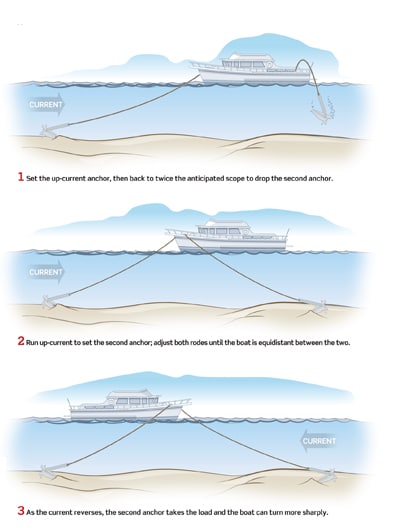Shifting winds and changing tides can move an anchored boat all over the place. One way to limit this swing is to set a second anchor. The classic two-anchor scenario is the Bahamian Moor. Its original purpose was to limit swing when anchored in a narrow channel swept by reversing tidal flow, but it can be handy anywhere wind and current change directions frequently.
To set a Bahamian Moor, start by anchoring into the current in the normal fashion [1]. Back down and set the hook, then keep reversing to twice the distance you ultimately plan to secure the anchor rode. Drop your second anchor directly down-current of the first, set the second anchor, and then move back to a point halfway between the two. On many boats, it might be easier to set the second anchor using a stern cleat, because this keeps the anchor line away from the props. Once the anchor is set, you can transfer the line to the bow [2].

The basic Bahamian Moor isn’t without problems: If there’s any slack on the lines, the one not under load may drift into the running gear; not all anchor chocks are designed to handle two opposing lines; and after multiple tide/wind shifts, the two lines may become hopelessly twisted.
Crews have tried all sorts of remedies to prevent line fouling, often involving conjoined anchor lines, drop weights and tethers. The most straightforward solution is simply to transfer the lines from the bow anchor chock to the forward deck cleats, leaving just enough slack to allow the boat to pivot [3]. Depending on the deck and cleat configuration, it may be necessary to add chafe protection.
A modification of the Bahamian Moor can also be used to limit swing caused by variable winds. Instead of setting the anchors in a straight line, you can set a V-shaped pattern with the open end facing in the general direction of the wind. With this rig, wind shifts won’t send you spinning all over the harbor.









